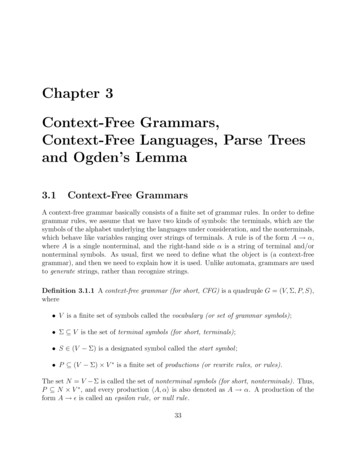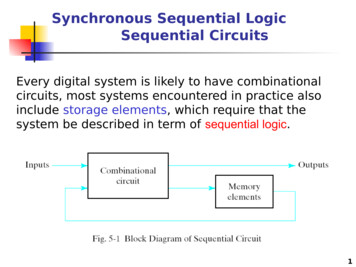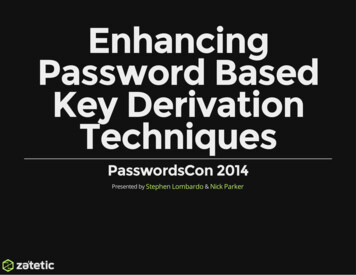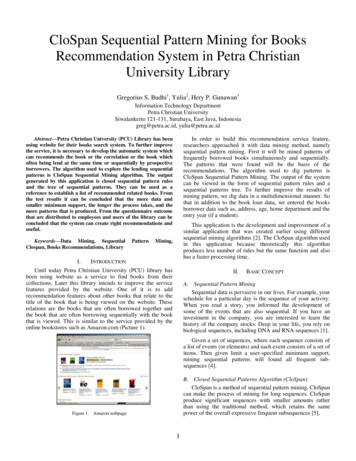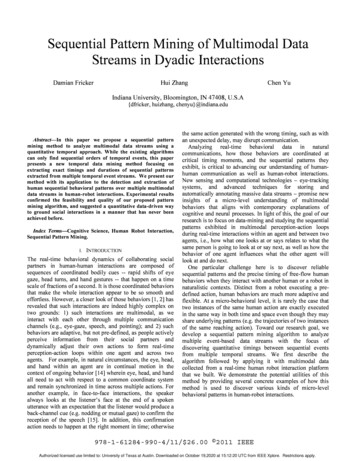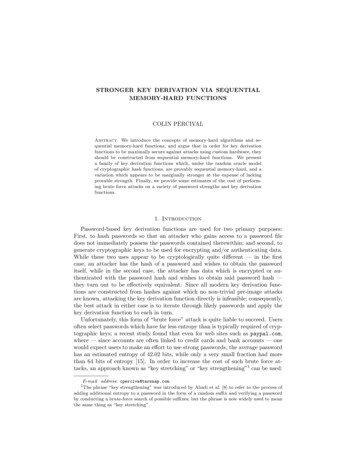
Transcription
STRONGER KEY DERIVATION VIA SEQUENTIALMEMORY-HARD FUNCTIONSCOLIN PERCIVALAbstract. We introduce the concepts of memory-hard algorithms and sequential memory-hard functions, and argue that in order for key derivationfunctions to be maximally secure against attacks using custom hardware, theyshould be constructed from sequential memory-hard functions. We presenta family of key derivation functions which, under the random oracle modelof cryptographic hash functions, are provably sequential memory-hard, and avariation which appears to be marginally stronger at the expense of lackingprovable strength. Finally, we provide some estimates of the cost of performing brute force attacks on a variety of password strengths and key derivationfunctions.1. IntroductionPassword-based key derivation functions are used for two primary purposes:First, to hash passwords so that an attacker who gains access to a password filedoes not immediately possess the passwords contained therewithin; and second, togenerate cryptographic keys to be used for encrypting and/or authenticating data.While these two uses appear to be cryptologically quite different — in the firstcase, an attacker has the hash of a password and wishes to obtain the passworditself, while in the second case, the attacker has data which is encrypted or authenticated with the password hash and wishes to obtain said password hash —they turn out to be effectively equivalent: Since all modern key derivation functions are constructed from hashes against which no non-trivial pre-image attacksare known, attacking the key derivation function directly is infeasible; consequently,the best attack in either case is to iterate through likely passwords and apply thekey derivation function to each in turn.Unfortunately, this form of “brute force” attack is quite liable to succeed. Usersoften select passwords which have far less entropy than is typically required of cryptographic keys; a recent study found that even for web sites such as paypal.com,where — since accounts are often linked to credit cards and bank accounts — onewould expect users to make an effort to use strong passwords, the average passwordhas an estimated entropy of 42.02 bits, while only a very small fraction had morethan 64 bits of entropy [15]. In order to increase the cost of such brute force attacks, an approach known as “key stretching” or “key strengthening”1 can be used:E-mail address: cperciva@tarsnap.com.1The phrase “key strengthening” was introduced by Abadi et al. [8] to refer to the process ofadding additional entropy to a password in the form of a random suffix and verifying a passwordby conducting a brute-force search of possible suffixes; but the phrase is now widely used to meanthe same thing as “key stretching”.
2STRONGER KEY DERIVATION VIA SEQUENTIAL MEMORY-HARD FUNCTIONSBy using a key derivation function which requires 2s cryptographic operations tocompute, the cost of performing a brute-force attack against passwords with t bitsof entropy is raised from 2t to 2s t operations [19].This approach has been used with an increasing degree of formalism over theyears. The original UNIX CRYPT function — dating back to the late 1970s —iterated the DES cipher 25 times in order to increase the cost of an attack [22],while Kamp’s MD5-based hash [18] iterated the MD5 block cipher 1000 times; morerecently, Provos and Mazières’ bcrypt [24] and RSA Laboratories’ PBKDF1 andPBKDF2 [17] are explicitly defined to perform a user-defined number of iterations2,with the number of iterations presumably being stored along with the password salt.Providing that the number of iterations used is increased as computer systemsget faster, this allows legitimate users to spend a constant amount of time on keyderivation without losing ground to attackers’ ever-increasing computing power —as long as attackers are limited to the same software implementations as legitimateusers. However, as Bernstein famously pointed out in the context of integer factorization [10], while parallelized hardware implementations may not change thenumber of operations performed compared to software implementations, this doesnot prevent them from dramatically changing the asymptotic cost, since in manycontexts — including the embarrassingly parallel task of performing a brute-forcesearch for a passphrase — dollar-seconds are the most appropriate units for measuring the cost of a computation3. As semiconductor technology develops, circuits donot merely become faster; they also become smaller, allowing for a larger amountof parallelism at the same cost. Consequently, using existing key derivation algorithms, even if the iteration count is increased such that the time taken to verify apassword remains constant, the cost of finding a password by using a brute forceattack implemented in hardware drops each year.This paper aims to reduce the advantage which attackers can gain by usingcustom-designed parallel circuits.2. Memory-hard algorithmsA natural way to reduce the advantage provided by an attacker’s ability toconstruct highly parallel circuits is to increase the size of a single key derivationcircuit — if a circuit is twice as large, only half as many copies can be placed on agiven area of silicon — while still operating within the resources available to softwareimplementations, including a powerful CPU and large amounts of RAM. Indeed,in the first paper to formalize the concept of key stretching [19] it is pointed outthat requiring “32-bit arithmetic and use of moderately large amounts of RAM4”can make hardware attacks more expensive. However, widely used key derivation2It should be noted, however, that when used to verify login passwords, the “user-defined”value is typically stored in a system configuration file which the vast majority of users nevermodify.3That is, the price of hardware times the amount of time for which it needs to be used; this isanalogous to the common AT (area times time) cost measure used in the context of VLSI circuitdesign. The ability of parallel designs to achieve a lower cost for the same number of operationsis essentially due to their ability to use a larger fraction of die area for computational circuits.4The example given is 256 32-bit words, which hardly qualifies as “moderately large” at thepresent time, and is questionable even in the context of hardware of the time (1997) given thateven low-end PCs rarely had less than 4 MB of RAM (that being the official minimum requirementto run the Windows 95 operating system).
STRONGER KEY DERIVATION VIA SEQUENTIAL MEMORY-HARD FUNCTIONS3functions have thus far used constant amounts of logic and memory; in order toincrease the cost of a parallel attack, we would like to parameterize not only theoperation count, but also the memory usage. To this end, we introduce the followingdefinition:Definition 1. A memory-hard algorithm on a Random Access Machine is an algorithm which uses S(n) space and T (n) operations, where S(n) Ω T (n)1 ǫ .A memory-hard algorithm is thus an algorithm which asymptotically uses almostas many memory locations as it uses operations5; it can also be thought of as analgorithm which comes close to using the most memory possible for a given numberof operations, since by treating memory addresses as keys to a hash table it is trivialto limit a Random Access Machine to an address space proportional to its runningtime.Requiring an amount of memory approximately proportional to the number ofoperations to be performed also happens to meet our objective of creating expensivehardware implementations while staying within the resources available to a softwareimplementation. A widely used rule of thumb in high performance computing isthat balanced systems should have one MB of RAM for every million floating-pointoperations per second of CPU performance; outside of high performance computingthis ratio varies somewhat depending on the field — for instance, home PCs tendto have more MFLOPS than MB, while database servers tend to have more MBthan MFLOPS — but these ratios have remained remarkably constant over severaldecades.3. HEKSIn contrast to the aforementioned widely-used key derivation functions, whichall operate within a constant memory size, the HEKS key derivation algorithm [25]— introduced by Reinhold in 1999, but apparently never used [26] — is designed touse an arbitrarily large amount of memory6. Reinhold constructs a linear congruential pseudo-random number generator and feeds it into a Bays-Durham shufflingPRNG [9], then accumulates the output of the Bays-Durham PRNG in a vectorof 16 words; that 16-word vector is periodically hashed to reseed the PRNGs, andonce enough iterations have been performed, said hash is output as the derived key.Algorithm HEKS-D1(P, S, L, N, K)Input:PPassword (P0 P1 . . . Pr 1 ) of length r octets.SSalt (S0 S1 . . . St 1 ) of length t octets.K, L, NInteger parameters.Output:(w0 . . . w4 )32-bit integers.Steps:1: (w0 , w1 , w2 , w3 , w4 ) SHA1(P0 P1 . . . Pr 1 S0 S1 . . . St 1 )2: X w03: a (w1 & 0x04000002) 0x020000055We allow the T (n)ǫ to account for factors of log (S(n)) which inevitably arise from varyingmodels of Random Access Machines with vast address spaces.6As specified, HEKS is limited to using 232 32-bit values; but the design is trivially extendableby replacing 32-bit integers with 64-bit or longer integers.
4STRONGER KEY DERIVATION VIA SEQUENTIAL MEMORY-HARD FUNCTIONSb w2 0x00000001G w4for i 0 to 15 doBi 08: end for9: for i 0 to L 1 do10:X (aX b) mod 23211:Vi X Pi mod r mod 23212: end for13: for n 0 to N 1 do14:for i 0 to K 1 do15:j G mod L16:G Vj17:X (aX b) mod 23218:Vj X19:Bi mod 16 Bi mod 16 G mod 23220:end for21:if n r then22:B1 B1 Pn mod 23223:end if24:(w0 , w1 , w2 , w3 , w4 ) SHA1 Compress ((w0 , w1 , w2 , w3 , w4 ), B0 . . . B15 )25:X X w0 mod 23226:a w127:b w228:G w429: end forThere is a significant bug in this algorithm as stated above7: When the linear congruential generator is reinitialized on lines 25–27, there is no guaranteethat the multiplier a is odd (unlike when the LCG is first initialized at lines 2–4); consequently, 50% of the time the LCG will rapidly degrade to the fixed pointb(1 a) 1 mod 232 . However, we do not believe that this error causes any significant reduction in the security of HEKS: If a large proportion of the entries in Vare the same, then for even values of a the sequence of values of G in the innerloop (lines 14–20) will reach a fixed point shortly after the sequence of values ofX; but for odd values of a, the sequence of values of G will not easily reach a fixedpoint. Consequently, in the algorithm as stated the vector V is likely to reach anequilibrium point where it has many duplicate entries but still contains significantentropy. Reinhold suggests that the parameter K should be chosen to be L or larger,that L should be “as large as the user or user community can comfortably provide onthe smallest machine on which they plan to use the algorithm”, and that N shouldbe determined as necessary to make the computation take the desired duration.Since HEKS takes, on a sequential machine, O(L) space and O(L N K) time, it ismemory-hard for N O(L1 ǫ K 1 ), e.g., if N, K O( L); and if the parametersare chosen as suggested, HEKS only fails to be memory-hard if there is not sufficientmemory to match the desired duration of computation.4:5:6:7:7Reinhold’s description of the algorithm matches his C source code, so presumably this is notmerely a typographical error.
STRONGER KEY DERIVATION VIA SEQUENTIAL MEMORY-HARD FUNCTIONS5However, this alone is not sufficient to eliminate the asymptotic advantage ofan attacker armed with parallel hardware. On a parallel random access machinewith L processors and O(L) space, the next Ω(L0.5 ǫ ) outputs of the Bays-DurhamPRNG can be computed in O(log L) time by applying binary powering to the permutation j Vj mod L to compute the initial non-repeating sequence of valuesj; and the kth output of a linear congruential PRNG can be computed on a single processor in O(log k) time. Consequently, a parallel random access machinewith O(L) CPUs and O(L) space can compute the HEKS key derivation functionin O(N KL 0.5 ǫ ) time, resulting in a computation cost of O(N KL0.5 ǫ ) dollarseconds — a very significant advantage over the O(L2 N KL) cost of a naı̈vesequential implementation.4. Sequential memory-hard functionsClearly the inadequacy of HEKS as a key derivation function is due to its abilityto effectively use multiple processors: While HEKS makes good use of a resource(RAM) which software implementations have in large supply, it can also makegood use of a resource (computational parallelism) which is far more available ina hardware attack. To provide a framework for functions immune to this sort ofattack, we introduce the following definition:Definition 2. A sequential memory-hard function is a function which(a) can be computed by a memory-hard algorithm on a Random Access Machinein T (n) operations; and(b) cannot be computed on a Parallel Random Access Machine with S (n)processors and S (n) space in expected time T (n) where S (n)T (n) O(T (n)2 x ) for any x 0.Put another way, a sequential memory-hard function is one where not only thefastest sequential algorithm is memory-hard, but additionally where it is impossiblefor a parallel algorithm to asymptotically achieve a significantly lower cost. Sincememory-hard algorithms asymptotically come close to using the most space possible given their running time, and memory is the computationally usable resourcegeneral-purpose computers have which is most expensive to reproduce in hardware8,we believe that, for any given running time on a sequential general-purpose computer, functions which are sequential memory-hard come close to being the mostexpensive possible functions to compute in hardware.Indeed, it is surprising to consider the effect of adjusting parameters so that asequential memory-hard function takes twice as long to compute: As long as thereis enough random-access memory to compute the function on a general-purposesystem, doubling the time spent asymptotically results in the cost of computingthe function in hardware increasing four-fold, since the time and required space areboth doubled.8On many general-purpose systems, the CPU and motherboard are more expensive than theRAM; but the vast majority of that cost is due to the requirements of general-purpose computation, rapid sequential computation, and support for peripheral devices. The area occupied bycomputation logic on modern CPUs is vanishingly small compared to caches, instruction decoding,out-of-order execution, and I/O.
6STRONGER KEY DERIVATION VIA SEQUENTIAL MEMORY-HARD FUNCTIONS5. ROMixThe definition of sequential memory-hard functions, while theoretically interesting in its consequences, would not be of any practical value if it turned out thatno sequential memory-hard functions exist; to that end, we introduce the class offunctions ROMixH : {0, 1}k {0 . . . 2k/8 1} {0, 1}k computed as follows9:Algorithm ROMixH (B, N )Parameters:HA hash function.kLength of output produced by H, in bits.IntegerifyA bijective function from {0, 1}k to {0, . . . 2k 1}.Input:BInput of length k bits.NInteger work metric, 2k/8Output:B′Output of length k bits.Steps:1: X B2: for i 0 to N 1 do3:Vi X4:X H(X)5: end for6: for i 0 to N 1 do7:j Integerify(X) mod N8:X H(X Vj )9: end for10: B ′ XThis algorithm can be thought of as computing a large number of “random”values, and then accessing them “randomly” in order to ensure that they are allstored in Random Access Memory. Before we can prove anything more formally,we need a simple lemma concerning the iterated application of random oracles.Lemma 1. Suppose that two algorithms, Algorithm A and Algorithm B exist suchthat(1) Algorithm A takes as input the integers N , M , and k, a k-bit value B,and an oracle H : {0, 1}k {0, 1}k , and produces a kM -bit output valueAN,M,k (B, H); and(2) Algorithm B takes as input the integers N , M , k, and x, with 0 x N ,and AN,M,k (B, H); and operates on a system which can simultaneouslyconsult M copies of the oracle H in unit time and perform any other computations instantaneously, to compute the value H x (B).Then if the values H 0 (B) . . . H N 1 (B) are distinct and N 2k/8 , Algorithm Boperates in expected time at least 4MN 2 21 for random oracles H, k-bit values B,and integers x {0 . . . N 1}.9We expect that for reasons of performance and simplicity, implementors will restrict N tobeing a power of 2, in which case the function Integerify can be replaced by reading the first (orlast) machine-length word from a k-bit block.
STRONGER KEY DERIVATION VIA SEQUENTIAL MEMORY-HARD FUNCTIONS7Proof. For notational simplicity, we consider N , M , and k to be fixed and omitthem from variable subscripts.Consider the Process B*, taking input A(B, H), and operating on a machinewhich can simultaneously consult N M copies of the oracle H in unit time andperform any other computations instantaneously, defined as follows10: ExecuteAlgorithm B for each integer x {0 . . . N 1} in parallel (using up to M oraclesfor each value x); after Algorithm B has completed for a value x and has returnedthe value H x (B), input that value to an oracle in the following step; finally, if anyoracles are unneeded (due to Algorithm B not using all M oracles at some point,due to Algorithm B having finished, or because two or more instances of AlgorithmB are inputting the same value into oracles) then input arbitrary unique values tothem11.Now define Ri (B, H) {0, 1}k for i N/M 1 to be the set of values input by Process B* to the N M oracles at time i, define R̄i (B, H) R0 (B, H) R1 (B, H) . . . Ri (B, H), and define H̄(B) {H 0 (B), . . . H N 1 (B)}. Clearly if Algorithm B computes H x (B) in time t for some B, H, x, then H x (B) Ri (B, H) R̄i (B, H) for all i t. We will proceed by bounding the expected size of R̄i (B, H) H̄(B) for any process taking a kM bit input and operating on N M oracles.Let R̄i 1 (B, H) and the values of H evaluated thereupon be fixed, and consider the probability, over random B, H, that H x (B) R̄i (B, H). Trivially, ifH x 1 (B) R̄i 1 (B, H), then P (H x (B) R̄i (B, H)) 1 (since the probability ofanything is at most 1); but if H x 1 (B) / R̄i 1 (B, H) then the value of H evaluated at H x 1 (B) is entirely random; so P (H x (B) R̄i (B, H)) R̄i (B, H) ·2 k kN M (i 1)2 k N 2 2 k . Now suppose that out of the 22 1 N M i values of (B, H)ksuch that H takes the specified values, s · 22 1 N M i of them (i.e., a proportion s)result share the same value A(B, H). Then the values of R̄i (B, H) H̄(B) for suchkB, H are at most equal to the s · 22 1 N M i largest values of R̄i (B, H) H̄(B)for permissible H.However, the Chernoff bound states that for X a sum of independent 0-1 variables, µ E(X) and Y a constant greater than µ,P (X Y ) exp(Y µ Y (log µ log Y )),and so for Y 1 we haveP ( R̄i (B, H) H̄(B) R̄i 1 (B, H) H̄(B) Y ) exp(Y N 3 2 k Y (log(N 3 2 k ) log(Y ))) exp(Y Y log(N 3 2 k )) Y Y eN 3 2k 2k/2kand thus we find that, for (B, H) in the set of s · 22 1 N M i values such thatA(B, H) and H evaluated on R̄i 1 (B, H) take the correct values,E( R̄i (B, H) H̄(B) ) R̄i (B, H) H̄(B) log(s 1 )/ log(2k/2 ) 1,10We refer to the Process B* instead of the Algorithm B* since it neither produces output norterminates.11Thus for any B, H, Process B* inputs disjoint sets of N M values to the oracles at successivetime steps.
8STRONGER KEY DERIVATION VIA SEQUENTIAL MEMORY-HARD FUNCTIONSwhere the 1 arises as a trivial upper bound on the contribution from the exponentially decreasing probabilities of values X Y for X Y .Now we note that E( R̄i (B, H) H̄(B) ), with expectation taken over all values(B, H) is merely the average of the 2N M i M k values E( R̄i (B, H) H̄(B) ) withthe expectation taken over (B, H) consistent with a given A(B, H) and values ofH at R̄i 1 (B, H); and by convexity, the resulting bound is weakest when all of thevalues s are equal, i.e., s 2 M k . Consequently, we obtain (with the expectationtaken over all (B, H))E( R̄i (B, H) H̄(B) ) R̄i (B, H) H̄(B) 2M 1 (2M 1) · (i 1).The result now follows easily: Writing tx as the expected time taken by Algorithm B to compute H x (B) and noting that the time it takes to compute H x (B)is equal to the number of sets R̄i (B, H) which do not contain H x (B), we haveN 1 1 X1 Xtx N E( R̄i (B, H) H̄(B) )N x 0N i 01 N1 N N2M 1 1Xi 0N E( R̄i (B, H) H̄(B) )N2M 1 1Xi 0N (2M 1)(i 1)1N 4M 2 2as required. While this proof is rather dense, the idea behind it is quite simple: If the valueH x 1 (B) has not yet been computed, there is no way to compute H x (B); andwith only kM bits of information stored in A(B, H), any algorithm will be limitedto computing O(M ) values H x (B) from A(B, H) directly and then iterating Hto compute the rest. We believe that the “correct” lower bound on the expectedN 12 , but this appears difficult to prove.running time is in fact 2MIn spite of being marginally weaker than desirable, this lemma is still sufficientto prove the following theorem:Theorem 1. Under the Random Oracle model, the class of functions ROMixH aresequential memory-hard.Proof. The algorithm stated earlier uses O(N ) storage and operates in O(N ) timeon a Random Access Machine, so clearly the functions can be computed by amemory-hard algorithm in T (N ) O(N ) operations.Now suppose that ROMixH can be computed in S (N ) M (N ) space. SinceH is a random oracle, it is impossible to compute the function without computingeach of the values Vj and X in steps 6–9 of the sequential algorithm in turn; butby Lemma 1, it takes at least O(N/M (N )) time to compute each Vj .Consequently, it takes at least T (N ) O(N 2 /M (N )) time to compute thefunction, and thus S (N )T (N ) O(N 2 ) as required.
STRONGER KEY DERIVATION VIA SEQUENTIAL MEMORY-HARD FUNCTIONS96. SMixWhile ROMix performs well on a theoretical Random Access Machine, it suffers somewhat on real-world machines. In the real world, random access memoryisn’t; instead, factors such as caches, prefetching, and virtual memory12 make small“random” memory accesses far more expensive than accesses to consecutive memory locations.Existing widely used hash functions produce outputs of up to 512 bits (64 bytes),closely matching the cache line sizes of modern CPUs (typically 32–128 bytes), andthe computing time required to hash even a very small amount of data (typically200–2000 clock cycles on modern CPUs, depending on the hash used) is sufficientthat the memory latency cost (typically 100–500 clock cycles) does not dominatethe running time of ROMix.However, as semiconductor technology advances, it is likely that neither of thesefacts will remain true. Memory latencies, measured in comparison to CPU performance or memory bandwidth, have been steadily increasing for decades, andthere is no reason to expect that this will cease — to the contrary, switching delaysimpose a lower bound of Ω(log N ) on the latency of accessing a word in an N -byteRAM, while the speed of light imposes a lower bound of Ω( N ) for 2-dimensionalcircuits. Furthermore, since most applications exhibit significant locality of reference, it is reasonable to expect cache designers to continue to increase cache linesizes in an attempt to trade memory bandwidth for (avoided) memory latency.In order to avoid having ROMix become latency-limited in the future, it is necessary to apply it to larger hash functions. While we have only proved that ROMixis sequential memory-hard under the Random Oracle model, by considering thestructure of the proof we note that the full strength of this model does not appearto be necessary. The critical properties of the hash function required in order forROMix to be sequential memory-hard appear to be the following13:(1) The outputs of H are uniformly distributed over {0, 1}k .(2) It is impossible to iterate H quickly, even given access to many copies ofthe oracle and precomputation producing a limited-space intermediate.(3) It is impossible to compute Integerify(H(x)) significantly faster than computing H(x).Most notably, there is no requirement that the function H have the usual propertiesof collision and pre-image resistance which are required of cryptographic hashes.There are also two more criteria required of the hash function in order for ROMixto maximize the cost of a brute-force attack given an upper bound on the amountof computing time taken to compute the function in software:(4) The ratio of the hash length k to the number of operations required tocompute the hash function should be as large as possible.(5) The hash function should not have significantly more internal parallelismthan is available to software implementations.12Even if data is stored in RAM, the first access to a page typically incurs a significant costas the relevant paging tables are consulted.13The first requirement limits the number of values H x (B) which A(B, H) can uniquely identify; the second requirement ensures that values H x (B) which are not stored cannot be computedquickly; and the third requirement ensures that each iteration of the loop in lines 6–9 must complete before the next iteration starts.
10STRONGER KEY DERIVATION VIA SEQUENTIAL MEMORY-HARD FUNCTIONSIn light of these, we define the function BlockMixH,r computed as follows:Algorithm BlockMixH,r (B)Parameters:HA hash function.rBlock size parameterInput:B0 . . . B2r 1 Input vector of 2r k-bit blocksOutput:′B0′ . . . B2r 1Output vector of 2r k-bit blocks.Steps:1: X B2r 12: for i 0 to 2r 1 do3:X H(X Bi )4:Yi X5: end for6: B ′ (Y0 , Y2 , . . . Y2r 2 , Y1 , Y3 , . . . Y2r 1 )This function clearly satisfies condition (1) if the underlying H is uniformly distributed; it satisfies condition (3) if Integerify(B0 . . . B2r 1 ) is defined as a functionof B2r 1 ; and it is clearly optimal according to criteria (4) and (5) compared to anyfunctions constructed out of the same underlying H. We conjecture that BlockMixalso satisfies criteria (2), on the basis that the “shuffling” which occurs at step 6should thwart any attempt to rapidly iterate BlockMix using precomputed valueswhich uniquely identify some but not all of the values Bi ; but this does not appearto be easily proven14.Given that the performance of BlockMix according to criteria (4) and (5) isexactly the same as the performance of the underlying hash H, BlockMix is bestused with a hash which is fast while not possessing excess internal parallelism;based on this, it appears that Bernstein’s Salsa20/8 core [11] is the best-performingwidely studied cryptographic function available15. While Bernstein recommendsusing the Salsa20 core by adding diagonal constants [13] and uses it in this mannerin his Salsa20 cipher and Rumba20 compression functions, we do not believe thatthis is necessary when the Salsa20 core is being used in ROMix and BlockMix, sincethe related-input attacks against which they defend are not relevant in this context.Putting this together, we have the following:Definition 3. The function SMixr : {0, 1}1024r {0 . . . 264 1} {0, 1}1024ris SMixr (B, N ) ROMixBlockMixSalsa20/8,r (B, N ) where Integerify(B0 . . . B2r 1 ) isdefined as the result of interpreting B2r 1 as a little-endian integer.Theorem 2. The function SMixr (B, N ) can be computed in 4N r applications ofthe Salsa20/8 core using 1024N r O(r) bits of storage.Proof. The above algorithms operate in the required time and space. 14If the shuffling is omitted from BlockMix, it can be rapidly iterated given precomputed valuesB0 , since the computations would neatly “pipeline”.15Bernstein’s Chacha [12] appears to have a very slight advantage over Salsa20, but is newerand less widely used, and consequently has been less studied.
STRONGER KEY DERIVATION VIA SEQUENTIAL MEMORY-HARD FUNCTIONS117. scryptGiven a sequential memory-hard “mixing” function M F and a pseudorandomfunction P RF it is simple to construct a strong key derivation function. We define the class of functions MFcryptP RF,M F (P, S, N, p, dkLen) as computed by thefollowing algorithm:Algorithm MFcryptH,M F (P, S, N, p, dkLen)Parameters:P RFA pseudorandom function.hLenLength of output produced by P RF , in octets.F LenMFA sequential memory-hard function from ZM N256M F Lento Z256.M F LenLength of block mixed by M F , in octets.Intput:PPassphrase, an octet string.SSalt, an octet string.NCPU/memory cost parameter.pParallelization parameter; a positive integer satisfyingp (232 1)hLen/M F Len.dkLenIntended output length in octets of the derived key; apositive integer satisfying dkLen (232 1)hLen.Output:DKDerived key, of length dkLen octets.Steps:1: (B0 . . . Bp 1 ) PBKDF2P RF (P, S, 1, p · M F Len)2: for i 0 to p 1 do3:Bi M F (Bi , N )4: end for5: DK PBKDF2P RF (P, B0 k B1 k . . . k Bp 1 , 1, dkLen)This algorithm uses PBKDF2 [17] with the pseudorandom function P RF togenerate p blocks of length M F Len octets from the provided password and salt;these are independently mixed using the mixing function M F ; and the final outputis then generated by applying PBKDF2 once again, using the well-mixed blocksas salt16. Since, for large N , the calls to M F take asymptotically longer than thecalls to PBKDF2, and the blocks Bi produced using PBKDF2 are independent andrandom, subject to H being a random oracle, we note that if M F is a sequentialmemory-hard function then MFcrypt is sequential memory-hard under the randomoracle model.We now apply MFcrypt to the mixing function SMix from the previous sectionand the SHA256 hash function:Definition 4. The key derivation function scrypt is defined asscr
Definition 1. A memory-hard algorithm on a Random Access Machine is an al-T(n)1 ǫ. A memory-hard algorithm is thus an algorithm which asymptotically uses almost as many memory locations as it uses operations5; it can also be thought of as an algorithm which comes close to using the most memory possible for a given number

